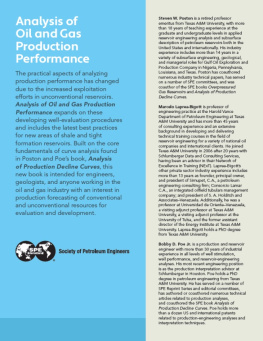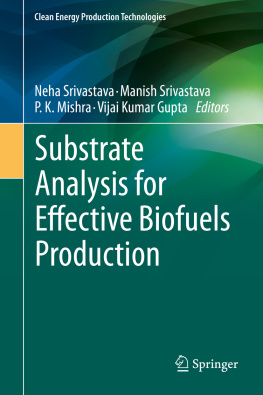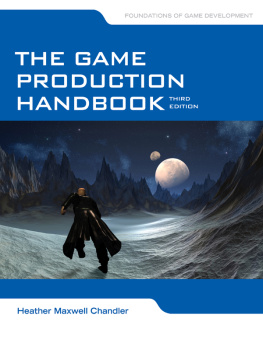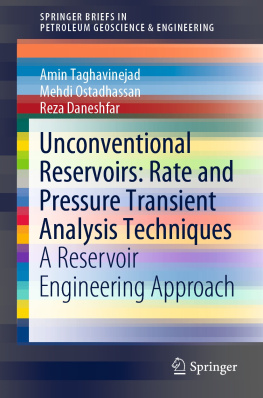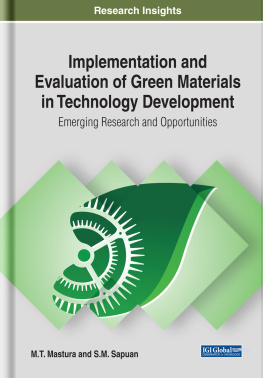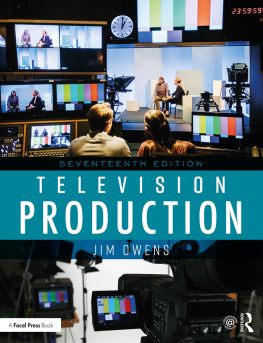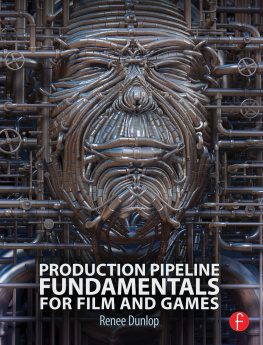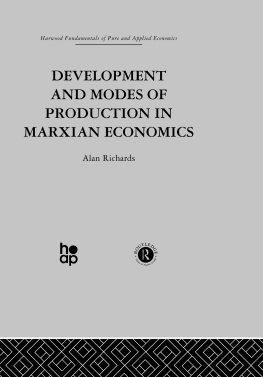
Analysis of Oil and Gas Production Performance
Copyright 2019 Society of Petroleum Engineers
All rights reserved. No portion of this book may be reproduced in any form or by any means, including electronic storage and retrieval systems, except by explicit, prior written permission of the publisher except for brief passages excerpted for review and critical purposes.
Printed in the United States of America.
Disclaimer
This book was prepared by members of the Society of Petroleum Engineers and their well-qualified colleagues from material published in the recognized technical literature and from their own individual experience and expertise. While the material presented is believed to be based on sound technical knowledge, neither the Society of Petroleum Engineers nor any of the authors or editors herein provide a warranty either expressed or implied in its application. Correspondingly, the discussion of materials, methods, or techniques that may be covered by patents implies no freedom to use such materials, methods, or techniques without permission through appropriate licensing. Nothing described within this book should be construed to lessen the need to apply sound engineering judgement nor to carefully apply accepted engineering practices in the design, implementation, or application of the techniques described herein.
ISBN 978-1-61399-665-2
First Printing 2019
Society of Petroleum Engineers
222 Palisades Creek Drive
Richardson, TX 75080-2040 USA
https://www.spe.org/store
1.972.952.9393
Dedication
This book is dedicated to the past, present, and future petroleum-engineering students passing through Texas A&M University.
Additionally, R. L. Whiting and D. von Gonten, former heads of the Department of Petroleum Engineering at Texas A&M University, should always be remembered for their foresight and efforts to expand and extend the scope of the department to the parents, state, and industry. R. Berg and R. Morse were of a great guidance and help while we were at the department.
Preface
Oil and gas companies are continually seeking and applying new technologies, processes, and methods to reduce their cost of finding and producing hydrocarbons while remaining competitive in the current and changing global economy. Improving the efficiency of business processes and maximizing the productivity of the workforce will help to reduce the associated costs and should ultimately increase profitability.
Although technology has helped companies to better evaluate the prospects, lack of trained geoscientists and engineers and the absence of proper vehicles for training and technology transfer may jeopardize oil- and gasfield-development efforts. An efficient and effective way to help develop core competencies for different jobs is to design tools and training actions to address these needs. In this book, workflows have been developed that apply key technology independently by analyzing the processes and solving example problems, thereby addressing the importance of integration of subsurface disciplines related to oil and gas exploration and production.
Traditional Arps models exist that are based on graphical extrapolation of production data, and they have been regarded in our industry as one of the preferred and commonly-used tools for estimating future performance in oil and gas wells. However, the practical aspects of analyzing production performance have changed as a result of the increased exploitation efforts in unconventional reservoirs. The complexities of these types of reservoirs were not adequately covered in the initial work Analysis of Production Decline Curves, published by the Society of Petroleum Engineers in October 2008. In the current book, the scope has been broadened, and we provide many more field examples, including problems that cover the specific subjects of developing well-evaluation procedures and best practices for new areas of shale and tight formation reservoirs.
Advances in horizontal well drilling and multistage hydraulic fracturing have allowed industry to develop unconventional nano-Darcy permeability reservoirs (shale oil and shale gas). These highly-heterogeneous multiphase systems do not lend themselves to typical analytical solutions to predict future performance. Boundary conditions applied to such systems are based on ideal geometrical configurations and idealized flow theory. This approach implies important and sometimes faulty assumptions concerning geological heterogeneity and multiphase flow in the physical system. Aspects of production forecasting in unconventional resources are now covered in this book. The sections discussing type curve and two phase flow have been expanded and revised completely, and an additional section on types of equations replicating different flow conditions encountered in the oil field is presented. The most useful plotting and interpretive methods have been added, and a method for estimating ultimate recovery is included.
This book is intended for engineers, geologists, and anyone working in the oil and gas industry with an interest in production forecasting of conventional and unconventional resources for evaluation and development. The majority of the book is concerned with commonly observed oilfield practice and practical solutions to the problems encountered therein. Each chapter begins with a workflow diagram that, in essence, provides the reader with the learning objectives of the chapter. A primary focus of the book is to instill each reader with the competency to solve typical operational problems with minimal exposure to the complexity of the underlying mathematics and equations. The basics and utility of each equation are discussed; however, the focus is on the practical application of the underlying technology to real-life problems. There are numerous illustrations and solutions to typical field problems included for the reader.
About the Authors
Steven W. Poston is a retired professor emeritus from Texas A&M University, with more than 18 years of teaching experience at the graduate and undergraduate levels in applied reservoir engineering analysis and subsurface description of petroleum reservoirs both in the United States and internationally. His industry experience includes more than 14 years in a variety of subsurface engineering, geological, and managerial roles for Gulf Oil Exploration and Production Company in Nigeria, Pennsylvania, Louisiana, and Texas. Poston has coauthored numerous industry technical papers, has served on a number of SPE committees, and was coauthor of the SPE books Overpressured Gas Reservoirs and Analysis of Production Decline Curves.
Marcelo Laprea-Bigott is professor of engineering practice at the Harold Vance Department of Petroleum Engineering at Texas A&M University and has more than 45 years of consulting experience and an extensive background in developing and delivering technical training courses in the field of reservoir engineering for a variety of national oil companies and international clients. He joined Texas A&M University in 2006 after 20 years with Schlumberger Data and Consulting Services, having been an advisor in their Network of Excellence in Training (NExT). Laprea-Bigotts other private sector industry experience includes more than 13 years as founder, principal owner, and president of Simupet, C.A., a petroleum engineering consulting firm; Consorcio Lamar C.A., an integrated oilfield tubulars management company; and president of S. A. Holditch and AssociatesVenezuela. Additionally, he was a professor at Universidad de OrienteVenezuela, a visiting adjunct professor at Texas A&M University, a visiting adjunct professor at the University of Tulsa, and the former assistant director of the Energy Institute at Texas A&M University. Laprea-Bigott holds a PhD degree from Texas A&M University.

